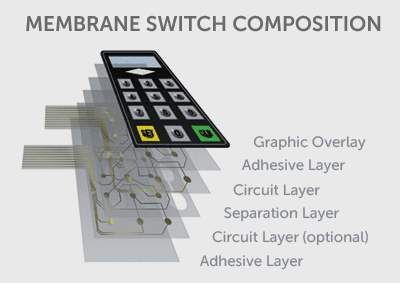Why a Membrane Switch Is Ideal for Industrial and Medical Applications
Understanding Membrane Switches: The Trick to Durable and Trustworthy Controls
Membrane switches over represent an essential element of modern user interface layout, blending functionality with strength in numerous applications. As we explore the details of membrane buttons, it comes to be clear that their role in improving control systems is both complicated and extensive, raising concerns concerning how finest to leverage their capabilities in future innovations.
What Are Membrane Layer Switches?
Membrane layer switches are an advanced remedy in the world of individual interface technology, combining performance and style flawlessly. These gadgets work as a user interface between individuals and digital systems, integrating numerous components right into a portable format. Typically built from adaptable, thin layers of products, membrane switches are made to react to touch, making it possible for individuals to interact with equipment and digital tools efficiently.
The main elements of a membrane button consist of a printed circuit layer, graphic overlay, and a spacer layer that prevents unintentional activation. The visuals overlay can be customized to mirror brand identity or user preferences, boosting visual appeals while making certain functionality. Membrane switches are typically utilized in numerous applications, consisting of medical tools, consumer electronics, and industrial equipment, owing to their sturdiness and resistance to environmental variables such as moisture and dirt.
One of the crucial benefits of membrane layer switches is their capability to withstand deterioration, making them optimal for high-traffic atmospheres. Furthermore, they are light-weight and need marginal area, enabling innovative layouts in item advancement. Overall, membrane layer switches represent a effective and practical selection for contemporary digital interfaces, marrying modern technology with user-centric style concepts.

Just How Membrane Layer Changes Work
The procedure of membrane layer changes hinges on a straightforward yet reliable device that translates customer input right into electronic signals. When a user presses the button, the leading layer flaws, permitting a conductive element in the circuit layer to make call with an equivalent conductive pad on the bottom of the graphic overlay.
The design of membrane layer switches can vary, however they commonly include domes or responsive components to supply responses to the individual, enhancing the total experience. The products used in membrane layer switches, such as polyester or polycarbonate, add to their sturdiness and resistance to environmental aspects, including dampness and dust. Furthermore, the published circuits are normally encapsulated, which secures them from damage in time.

Advantages of Membrane Buttons
One of the key benefits of membrane layer buttons is their adaptability in layout, permitting them to be personalized to satisfy specific customer needs and aesthetic requirements. This flexibility expands to helpful hints various sectors, where different shapes, dimensions, and colors can be employed to enhance individual interaction and aesthetic charm.
In addition, membrane buttons are known for their toughness. Built from durable materials, they are resistant to dirt, moisture, and physical wear, which substantially expands their life-span compared to standard mechanical switches. This sturdiness makes them specifically suitable for high-traffic settings and applications calling for long life.

Additionally, membrane buttons supply a streamlined profile, causing a thinner layout that can be integrated right into different gadgets without adding bulk. This feature not only enhances the visual charm but blog here additionally adds to a more ergonomic product layout.

Applications of Membrane Layer Switches
Functional and easy to use, membrane buttons find applications throughout a variety of markets, consisting of medical tools, customer electronic devices, and industrial tools. In the clinical field, these buttons are indispensable to gadgets such as analysis devices, individual monitoring systems, and infusion pumps, where dependability and simplicity of cleansing are crucial. Their ability to maintain and withstand severe settings performance makes them perfect for such applications.
In consumer electronic devices, membrane buttons are utilized in products like microwaves, washing machines, and remote controls - membrane switch. Their streamlined design enables for user-friendly interface, boosting the total user experience while supplying resilience and resistance to deterioration
Industrial equipment likewise gains from membrane layer buttons, specifically in control panels article source for equipment and automation systems. These buttons provide security versus dust and wetness, guaranteeing regular efficiency in challenging settings. Their personalized attributes allow makers to tailor them to certain functional demands, enhancing effectiveness and functionality.
Picking the Right Membrane Layer Switch Over
When picking a membrane layer button, it is necessary to consider numerous factors that affect efficiency and suitability for details applications. The primary factors to consider include environmental conditions, responsive comments, sturdiness, and layout specs.
First, examine the operating environment; switches subjected to dampness, chemicals, or extreme temperatures require details materials to make sure longevity and functionality. Next, review the demand for tactile responses. Relying on individual communication, some applications may gain from a tactile action to verify activation, while others may favor a non-tactile layout for visual reasons.
Resilience is another vital variable; membrane switches need to be made to endure frequent usage, effects, and abrasion. Guarantee the selected switch can withstand the expected lifecycle, particularly in high-usage scenarios.
Conclusion
In conclusion, membrane switches offer as crucial components in the style of sturdy and trusted control systems across numerous industries. The versatility of membrane changes allows for tailored options that satisfy details operational requirements, strengthening their significance in modern-day technology.
Membrane switches represent a critical aspect of modern interface layout, blending functionality with durability in different applications.Membrane layer buttons are a sophisticated solution in the realm of user interface technology, combining capability and layout flawlessly. Typically created from versatile, thin layers of products, membrane switches are made to respond to touch, making it possible for users to interact with equipment and digital gadgets effectively.
The style of membrane layer buttons can vary, yet they frequently include domes or responsive components to supply responses to the user, boosting the general experience.In verdict, membrane changes offer as crucial elements in the style of reliable and resilient control systems across various sectors.